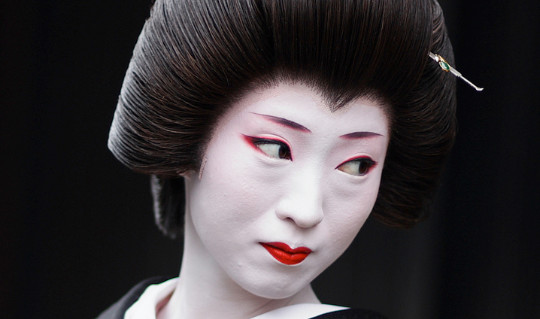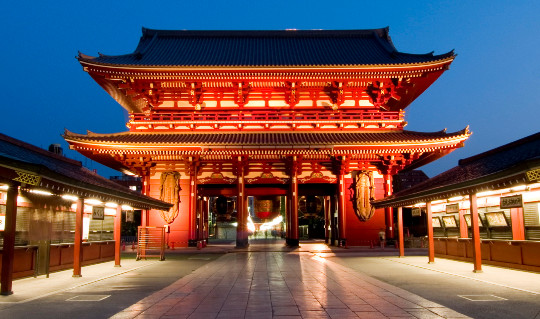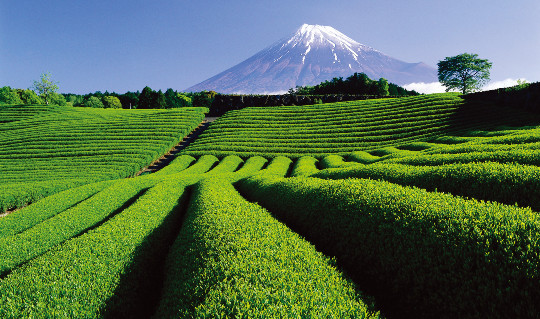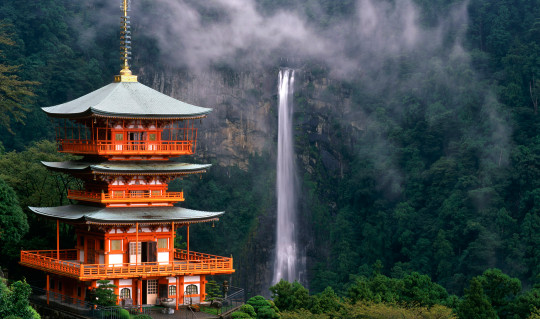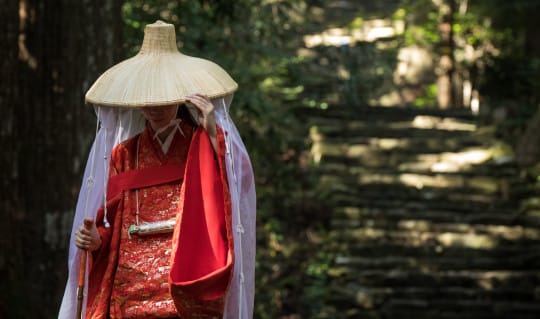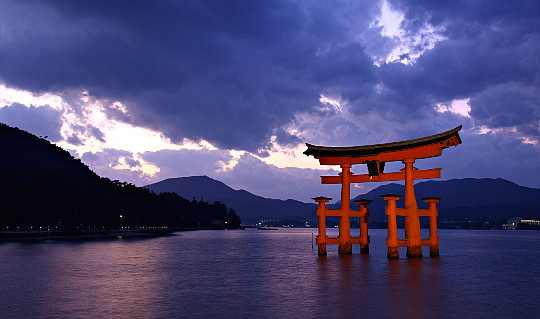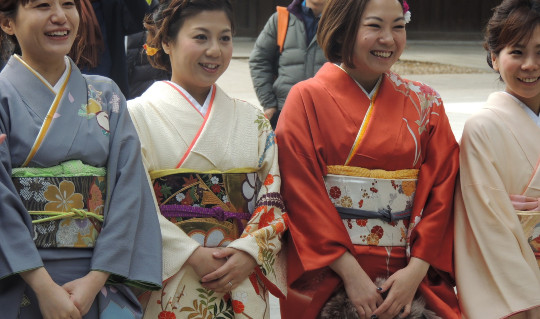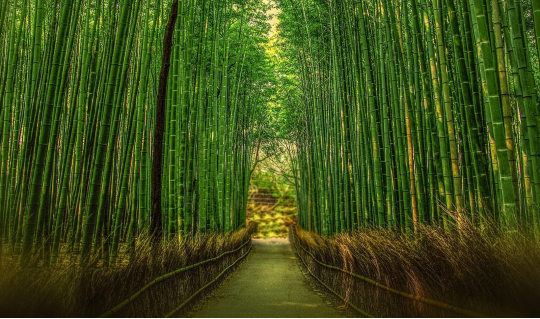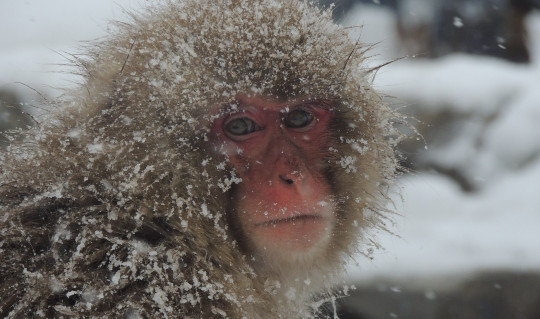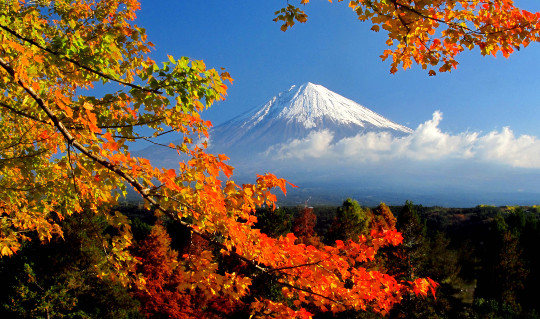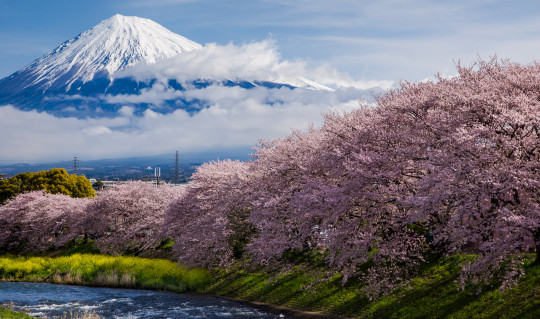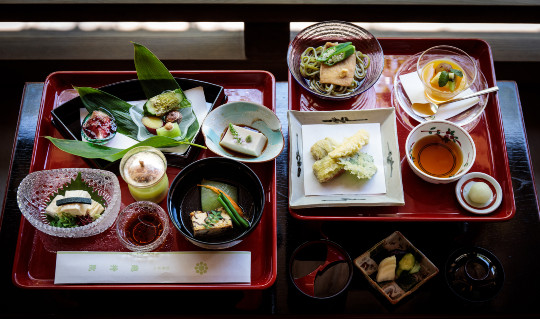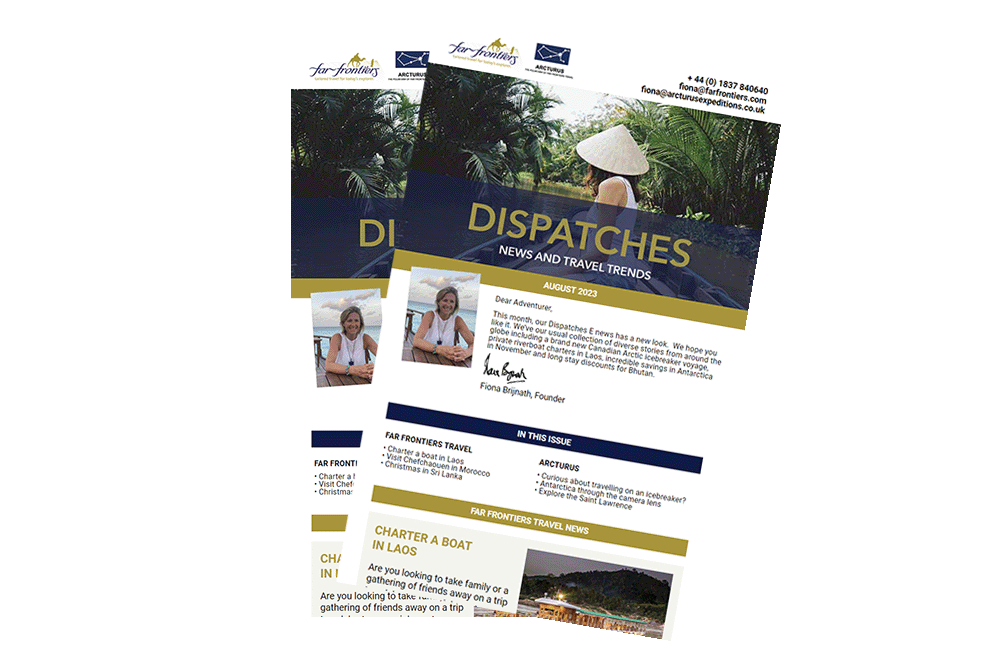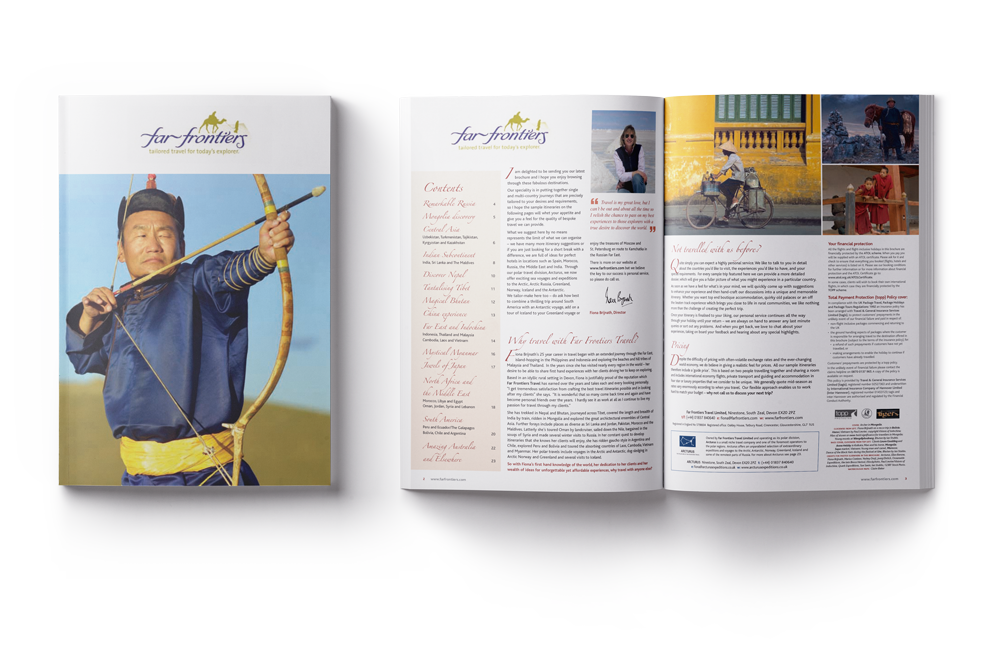January 2017
 “Location: Yudanaka, Honshu. I was in an enchanted forest. A magical trail thickly powdered with snow underfoot snaked its way through majestic pines, their branches hanging low, heavy with the burden of winter. The air was crystalline and occasionally engulfed by the silent plop and gentle wheeze of snow falling from lofty treetops – whereupon a myriad of tiny avalanches would send miniature snowballs rolling down the steep slope across my path.”
“Location: Yudanaka, Honshu. I was in an enchanted forest. A magical trail thickly powdered with snow underfoot snaked its way through majestic pines, their branches hanging low, heavy with the burden of winter. The air was crystalline and occasionally engulfed by the silent plop and gentle wheeze of snow falling from lofty treetops – whereupon a myriad of tiny avalanches would send miniature snowballs rolling down the steep slope across my path.”
“Within half an hour I had reached my goal – a secret fold in the mountains, where hidden springs ooze deliciously warm sulphurous tainted water, creating a perfect natural hot bath for the native population of Japanese macaques known as Snow Monkeys. I spent an unforgettable afternoon here watching them interact: The big male ever alert; tiny babies riding on the backs of their mothers; cheeky siblings grooming; and all on a constant mission to dig for food in the thick snow or huddle up to their necks in the warm waters. Out of red faces framed with thick coats sporting a snowy crown, their almond eyes watched inquisitively, knowingly – this is their territory but extraordinarily they don’t mind sharing it!
Later, the extremely efficient railway system brought me in less than four hours from a mountain village four feet deep in snow to the relatively balmy environs of Mount Fuji National Park. Here gently rolling hills, gushing rivers and deep water lakes have evolved from former calderas, and the imposing snow clad slopes of Mount Fuji (3,776m) – a giant in its surroundings – dominate the landscape. In the local town I slept in a Japanese Ryokan (inn), mine dating from the 17th century, from the time of the warring Shogun period. There I donned a traditional Yakata (Japanese robe) and slippers and eschewed my western ways. I bathed in traditional hot spring baths open to the elements and dined on a variety of delicacies: delicate seaweed strips in soy, sticky rice with miso soup, crab cakes, thin strips of Hida beef steamed at my table, slivers of picked radish, sushi and salted fish – and that was just for breakfast!
Leaving your heavy boots and western clothes almost at the door, you step away from everyday stresses and escape to a serene world of simplicity, harmony and good food. That night I slept on a futon bed rolled out over traditional tatami rush matting and slid back the paper thin screen doors to hear the rush and gurgle of the river outside. Next morning, immersed to the neck in natural hot spring water, I marvelled at the contrast between this life of old and the hi-tech minutely-timetabled Japan of today.
Back to the present and the impressive high speed Shinkansen (bullet train) connected me back to hi-tech living and then onto one of the most picturesque rail journeys in Japan – a narrow track winding up through wooded gorges and past tiny houses with neat rows of azalea bushes to the little town of Takayama. I spent a sublime afternoon wandering the quaint streets of San-Machi Suji popping in and out of traditional homes of Takayama merchants and sake brewers whose houses have been preserved almost exactly as they were 200-300 years ago – and are now little shops. With the obligatory bottle of sake safely stowed in my baggage I headed north once more, trying not to think about the pristine trekking that I was missing in Hakusan National Park and making a mental note about the annual Takayama Festival – a twice yearly event in April and October during which the locals dress as Samurai and carry enormous colourful floats through the streets of the town. Some of these weigh over 2 tonnes and take the might of 80 men to move them. At night the floats are lit by hundreds of Japanese lanterns – now that would be worth seeing.
Think of a Swiss mountain village full of Devon thatched cottages and you have my next stop – the UNESCO World Heritage village of Shira-Kawago. I took a bus up into these remote mountains and discovered another Japan of old. Clusters of Gassho–Zukuri houses, over 250 years old, complement a glorious wooded valley with the snowy peaks of the Japan Alps rising majestically in the background. Their name means ‘constructed like hands in prayer’ and the renowned thatched roofs are designed to withstand the region’s heavy winter snowfall. Though the sky remained endlessly blue all day I could see (looking at some of the snowdrifts over 10ft high and houses thickly blanketed with snow) that the construction was really being put to the test.
Towards the end of my stay I made the journey to Kanazawa close to the Sea of Japan coast as I wanted to see the renowned gardens and some of the best preserved Samurai and Chaya (Geisha) entertainment districts for which the city is so famous. During World War II Kanazawa was Japan’s second largest city after Kyoto to escape destruction by air raid. Its attractions don’t disappoint. I wandered at dusk in the grounds of Kanazawa’s formidable moated castle, craning my neck upwards to see the monstrous block walls topped with pavilion-style clay tiled watchtowers and I felt dwarfed by its enormous wooden studded gates. The Samurai had many tricks up their sleeves for repelling invading armies. It must have been a fearful time. The following day, in the local museum, I read a section of a letter written in the mid-16th century by a clan chieftain thanking one of his followers for disposing of a particularly bothersome warrior and delivering his head in person! I digress!
My walk continued – stumbling across a superbly intricate Japanese garden in the shadow of the castle walls where a son et lumière played out over gracious sapporo and sleeping cedar trees and cast shadows of pink, blue and purple on the half-moon bridge centre piece.
The next day, ambling through the cobbled streets of Samurai and Geisha districts all with delicate wooden lattice windows and rice paper sliding doors, one could really imagine what life was like under the Edo period before Japan came to be ruled by the Emperors and the Imperial Family of its more recent history.
To complete my journey of contrasts, I retreated to Mount Koya, south of Osaka, for a last taste of the peace and solitude offered by a mountain hideaway. Here after a journey of multi train changes, I hopped onto a cable car to reach my final destination – Koyasan and its population of Buddhist monks.
This UNESCO world heritage site is home to over 100 temples and has been the centre of Shingon Buddhism in Japan for over 1,200 years. After a night in a simple Japanese style ‘Temple lodging’ where I took meals in my room and slept on a futon with a pillow stuffed only with beans (best sleep ever), an early morning start gave a privileged insight into the world of a Japanese Buddhist monk. Entering the Meditation Hall, I sat motionless while the monks started their morning service. The air was thick with the smell of incense, cymbals clashed, bells tinkled, candles flickered, kerosene heaters hissed and the all-pervading sound was the low monotone chants of the monks, breath like smoke, minds focused, bodies poised in repose. The fire temple was more dramatic. More chanting, but this time an enormous drum was used to great effect and a ritual fire blazed with fervour at the centre of the room sending showers of sparks up into the gloom of the ceiling. Leaving this cocoon I went out into the rain in search of the hugely sacred Mausoleum of Kobo Daishi, an extraordinary 1.6km walk through a 750 year old cedar forest, hundreds of ancient stone shrines to right and left hidden among the trees, drifting mist and only the eerie sight of stone lanterns penetrating the gloom. Being January there was snow and ice underfoot but the mausoleum was well worth the effort – all gold and fire, a sea of lanterns hanging from the rafters, golden candlesticks, offering plates, hangings and intricate Buddhist Statues. A jewel.
Kyoto was my final stop, the best preserved of Japan’s major cities, it has 17 UNESCO World Heritage sites to choose from as well as a thriving Geisha entertainment culture. I spent a fascinating evening with a local resident at a private members club with the opportunity to meet a Geisha, face to face, enjoy a little sake and talk with her. This is not a tourist gimmick. The elaborate, hair, white face stark against red lips and delicate and yet ornate eye make-up is something to behold. Poise, tranquillity, beauty, mysticism and laughter summed up my evening.
On 6 August 1945 the Americans dropped an Atomic Bomb on Hiroshima, a little over two hours by train from Kyoto. My visit, though brief, proved a haunting reminder of the evils of war. Ground Zero – one original building at Hiroshima still stands, or rather slumps, its broken walls and charred dome stand out starkly against the green of the Peace Memorial Park opposite and the gleaming tower blocks behind. I highly recommend a visit to the memorial museum – it will not fail to move you, but I am glad to say the city has shrugged off its appalling heritage and has changed once again out of all recognition – this time for the good.
As I reflect on my trip, how do I best summarise this extraordinary country? Truly a destination unlike anything else you will have experienced in Asia. The technology of today is ever present and the country runs completely to time, yet its age-old traditions are very much preserved and Japanese culture of respect, good manners, consideration of others and eagerness to do one’s best runs in a rich seam throughout. Don’t forget to bow, bring your watch, be ready to consult timetables and pack a small bag.
My one regret – I did not manage to see the sumo wrestlers in action! I leave that for next time. When all’s said and done, I give the last nod to Japan.”
when to go: AUTUMN/SPRING
Why not tailor our Best of Japan itinerary to coincide with the colourful maples of Autumn or the cherry blossom in Spring 2018? Takayama comes alive for its October and April festivals, when locals dress as Samurai and carry enormous colourful floats through the streets. At night these are lit by hundreds of Japanese lanterns – quite something to see.

